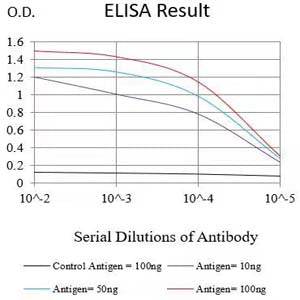
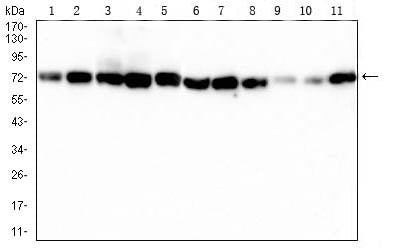
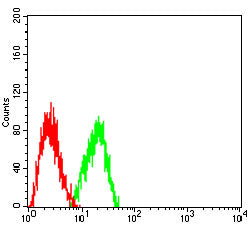
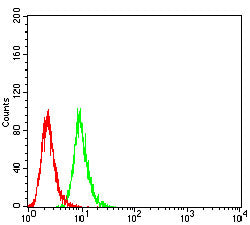
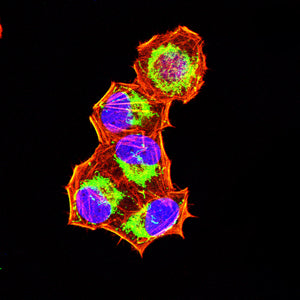
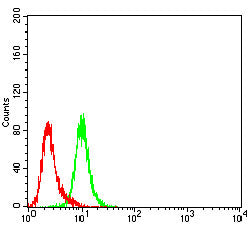
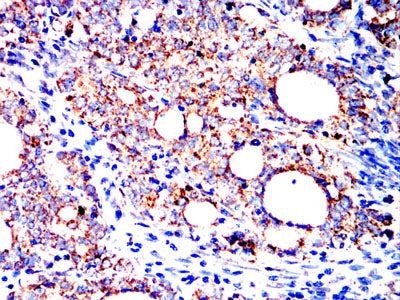
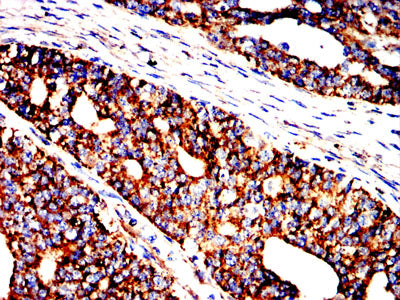
| WB | 1/500 - 1/2000 | Human,Rat,Monkey |
| IF | 咨询技术 | Human,Rat,Monkey |
| IHC | 1/200 - 1/1000 | Human,Rat,Monkey |
| ICC | 1/200 - 1/1000 | Human,Rat,Monkey |
| FCM | 1/200 - 1/400 | Human,Rat,Monkey |
| Elisa | 1/10000 | Human,Rat,Monkey |
| Aliases | CSA; MOT; MOT2; SAAN; CRP40; EVPLS; GRP75; PBP74; GRP-75; HSPA9B; SIDBA4; MTHSP75; HEL-S-124m |
| Entrez GeneID | 3313 |
| clone | 3A12G3 |
| WB Predicted band size | 74KDa |
| Host/Isotype | Mouse IgG1 |
| Antibody Type | Primary antibody |
| Storage | Store at 4°C short term. Aliquot and store at -20°C long term. Avoid freeze/thaw cycles. |
| Species Reactivity | Human,Rat,Monkey |
| Immunogen | Purified recombinant fragment of human HSPA9 (AA: 480-679) expressed in mammalian. |
| Formulation | Purified antibody in PBS with 0.05% sodium azide |
+ +
以下是关于HSPA9抗体的3篇参考文献,按文献名称、作者和摘要内容概括整理:
---
1. **文献名称**:*HSPA9/Mortalin regulates mitochondrial homeostasis in Parkinson's disease*
**作者**:Jin, S.M., et al.
**摘要**:研究通过HSPA9抗体检测发现,HSPA9在线粒体功能紊乱的帕金森病模型中表达降低,其缺失导致线粒体自噬失调和神经元死亡,提示HSPA9在神经退行性疾病中的保护作用。
---
2. **文献名称**:*Mortalin/HSPA9 interacts with β-catenin to promote colorectal cancer progression*
**作者**:Lu, W.J., et al.
**摘要**:利用HSPA9抗体进行免疫共沉淀实验,揭示了HSPA9通过结合β-catenin增强Wnt信号通路,促进结直肠癌细胞增殖和转移的分子机制。
---
3. **文献名称**:*Targeting HSPA9 sensitizes cancer cells to endoplasmic reticulum stress-induced apoptosis*
**作者**:Chen, Y., et al.
**摘要**:通过HSPA9抗体抑制其功能,研究发现HSPA9在癌细胞中通过调控内质网应激反应维持细胞存活,靶向该蛋白可增强化疗药物诱导的凋亡效应。
---
以上文献均通过HSPA9抗体开展实验,涉及神经退行性疾病、癌症信号通路及治疗策略的研究。如需更多文献或具体细节,可进一步提供方向补充。
HSPA9. also known as GRP75 or mortalin, is a member of the heat shock protein 70 (HSP70) family localized primarily in the mitochondrial matrix. It functions as a molecular chaperone, facilitating protein folding, mitochondrial import, and stress response. HSPA9 plays critical roles in maintaining mitochondrial homeostasis, regulating apoptosis, and supporting cellular proliferation. Its dysregulation is linked to various diseases, including cancer, neurodegenerative disorders (e.g., Parkinson’s disease), and metabolic syndromes. In cancer, HSPA9 overexpression is associated with tumor progression, metastasis, and chemoresistance, partly through interactions with p53 and other oncogenic pathways. In neurodegeneration, it interacts with PINK1/Parkin to influence mitochondrial quality control.
HSPA9 antibodies are essential tools for studying its expression, localization, and protein interactions. They are widely used in techniques like Western blotting, immunofluorescence, and immunoprecipitation to investigate HSPA9's role in cellular stress responses, mitochondrial dynamics, and disease mechanisms. Commercially available antibodies are typically validated for specificity using knockout cell lines or siRNA knockdown. Researchers also utilize HSPA9 antibodies to explore its potential as a therapeutic target or biomarker, given its involvement in pathophysiological processes. Cross-reactivity with homologs in model organisms (e.g., mice, rats) enables translational studies. Quality control emphasizes detecting the ~75 kDa protein and confirming mitochondrial subcellular localization.
×